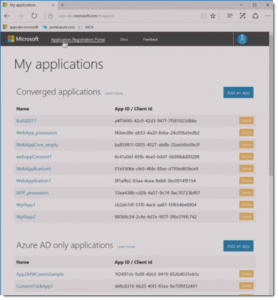Microsoft Identities: What’s new
At Build conference, a lot of new features were released. And of course, also in the Microsoft Identity space. This article will provide an overview of all the awesome new features that were covered there.
Azure Active Directory v2.0 Endpoint
The v2.0 endpoint allows developer to write apps that accept sign in from both Microsoft Accounts and Azure AD accounts, using one single authentication endpoint.
When your application makes a call to the Microsoft Graph, additional functionality and data will be available for Azure AD users. For instance, data from SharePoint and Microsoft Teams. But for reading a user's mail, or retrieving contacts, the code is exactly the same for both Microsoft and Azure AD accounts.
For more information about the v2.0 endpoint, check out the overview. However, there are some limitations to be aware of.
New Application Registration Portal
To register an app that works with the v2.0 endpoint, you must use the new application registration portal: https://apps.dev.microsoft.com.
One Application Middleware
In .Net Core 2.0 (preview), there is only one application middleware using different handlers for OpenID Connect, Cookies, etc. In the near future (approximately 1 or 2 weeks), this will be released for mobile applications as well.
Production-Ready MSAL Preview
At Build 2016 the first developer preview of the Microsoft Authentication Library (MSAL) was released for .NET. One year later, this SDK is now production ready and enhanced with MSAL iOS, MSAL Android and MSAL JavaScript.
MSAL is the successor of ADAL and works with Azure AD v2. This means, using this SDK, you can also log in using work & school accounts, personal accounts and Azure B2C.
For a sample using MSAL, check the following site: https://azure.microsoft.com/nl-nl/resources/samples/active-directory-dotnet-webapp-openidconnect-v2/.
Microsoft Graph
The number of data sets that are available through the Microsoft Graph are now increased:
- The SharePoint sites API, Planner API and OneNote APIs are now available in the Microsoft Graph v1.0 endpoint.
- The Microsoft Teams APIs, the New Insights APIs, the refreshed SharePoint list APIs and the Office Reporting APIs are now available in the Microsoft Graph beta endpoint.
Delta Query
Delta query enables applications to discover newly created, updated or deleted data without performing a full read with every request. Delta query is available for Users, Groups, Messages, Mail Folders, Calendar Events, Personal Contact, Contact Folders and Drives.
For more information, check the Delta Query overview.
New Webhooks
Applications can already subscribe to and receive notifications from several resources including messages, events, contacts, group conversations and drive root items.
Now, new subscriptions to Azure AD Users and Groups and additional support for Outlook.com resources were introduced.
For more information on webhooks, check the following site: https://dev.office.com/blogs/guide-to-office-at-build-2017.
Custom Data Extensions
You can extend the Microsoft Graph with your custom data. For instance, you can add your favorite color to your user profile data using the Graph. This new feature is now production-ready.
For more information, check the following article: https://dev.office.com/blogs/adding-customer-data-to-resources-in-Microsoft-Graph-preview.
Batching
Using JSON batching requests, multiple requests to the Microsoft Graph can now be combined in a single HTTP call.
More information will be posted in the upcoming weeks at https://developer.microsoft.com/en-us/graph/.
Azure Active Directory B2C
Azure Active Directory B2C, makes it easy for customers to sign in to applications using their existing social accounts (now Twitter as well). Besides that, you can also add your own.
For Azure AD B2C the following new features are available:
- MSAL (on all available platforms);
- The ASP.NET middleware (OpenId Connect) works with B2C;
- New web app templates for Visual Studio.
- Create custom identity policies.
Wrap Up
Lots of awesome new features regarding Microsoft Identities were released at build this year. I've tried to describe them all in this article but in case I've forgotten one, please let me know. I will then add them to the above overview.
Hopefully you are just as excited about this new features as I am!
-Sjoukje
Comments
- Anonymous
May 30, 2017
Handy summary. The updates to the identity stack were most welcome, and there's a ton of things to dig into here :)
